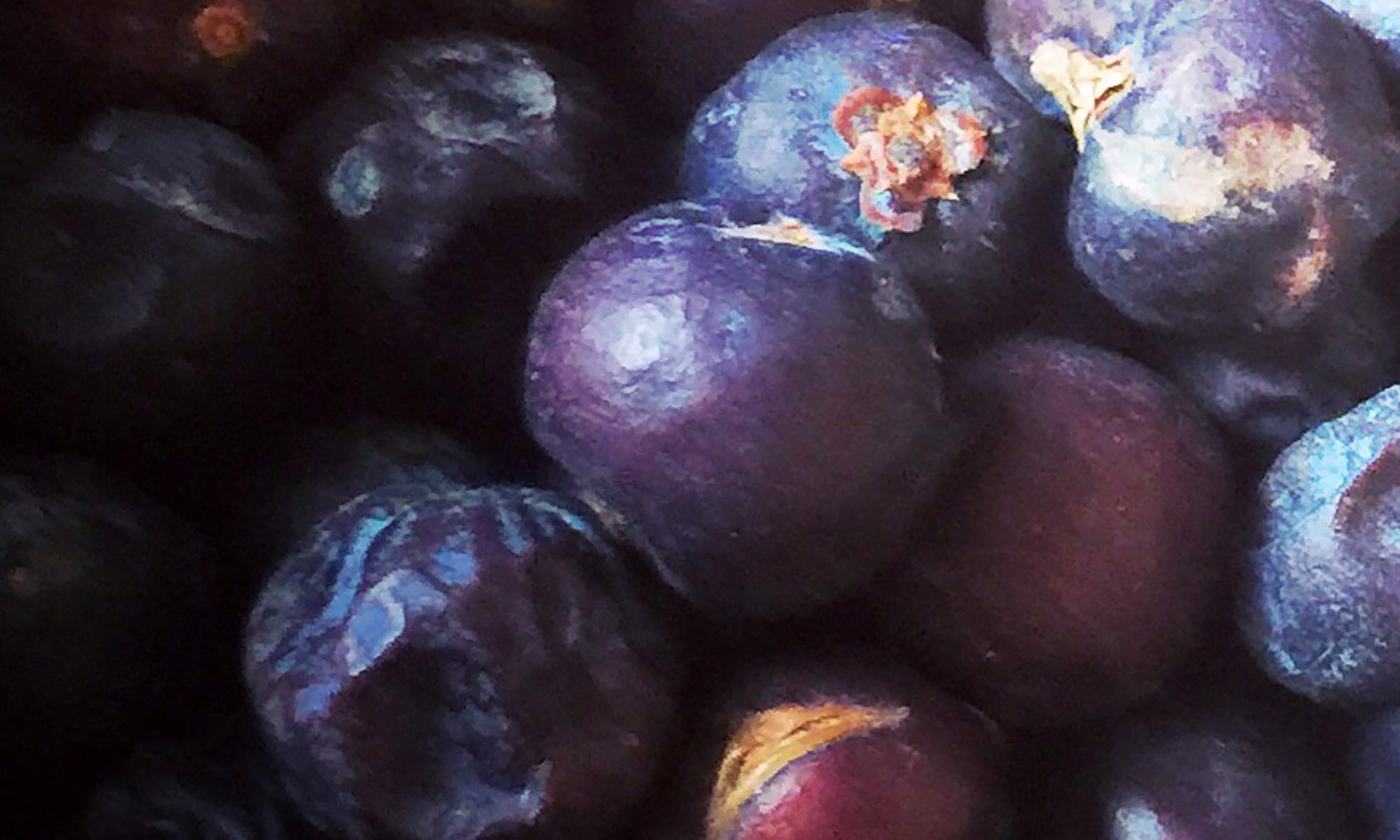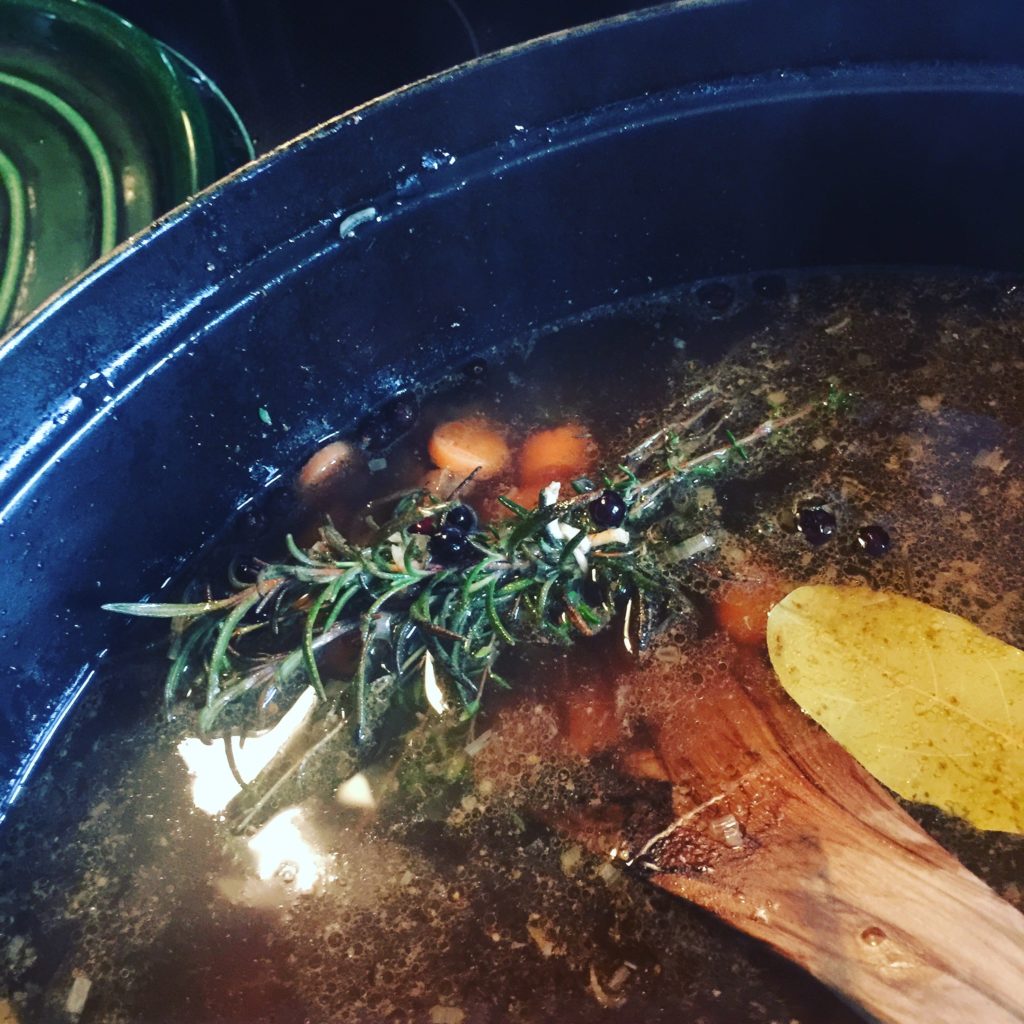Winter Garden Soup

Winter in Nashville is always like a slow waltz back and forth between fall and spring, with an occasion dash of winter. The days leading into this winter have been very different though, with more extreme weather events, both hot and cold.[i]

Throughout all of this I have been observing the plants that have survived these drastic temperature extremes, both the heat and the cold, since I believe that some of these plants are our future, as climate change begins to affect how we grow, eat, and live.
In addition to gardening differently, those of us who like to eat seasonally may find ourselves experimenting to create new recipes to accommodate the changing times when food is actually harvestable; blending ingredients that might normally be thought of as spring vegetables and herbs, with those that are normally harvested in the fall.
My typical way to make soup is to walk out in to the garden to see what is available. Because of the weather, there are not many options in the garden right now, so it would have to be a little of this and a little of that. The soup would be a blend of what was available in my garden, and what has already been harvested and stored for the winter.
Most of the plants in my garden had suffered damage from the hard frosts that we have had recently, so I only took small amounts from each of the surviving plants, so that they could continue growing. (Plant conservation can apply to vegetables, too.) The ones that still offered their leafy greens for the soup were: spinach, escarole, and even a small amount of French sorrel, which we usually think of as a spring vegetable. For herbs, I collected rosemary, thyme, and some luscious green parsley that, in spite of the weather, was flourishing.

Of the garden produce that had already been harvested and stored, I used grey shallots, garlic, and even some beets that I had canned during the summer. Then to round things out, a small cut of beef, some barley, and for a few added touches: Piment d’Espelette from France, balsamic vinegar from Italy, and bay leaves.
Then something else caught my eye, an ingredient that most of us in the US do not typically use: juniper berries. Its piney and citrusy flavor seemed a complimenting flavor that would match the lemony spring taste of the French Sorrel. Juniper berries are harvested in the fall, and as you will see, it is perfect timing for when we need them.
Juniper (Juniperus communis [ii]) has a history in many countries of being hung outside to ward off evil spirits. The Scottish people, (one of the groups I am descended from) burned juniper to cleanse and consecrate their homes, as well as also hanging it outside their doors to ward off evil and disease.[iii]
Based on recent studies it is not surprising that juniper has historically been used for cleansing and against infectious disease, since it has been shown to have anti-bacterial, anti-microbial, and anti-fungal properties, as well as anti-inflammatory, and antioxidant properties.[iv]
(As an aside, juniper is also the herb that gives gin its distinctive flavor.)

The other herbs in my soup, though we usually think of them as just culinary herbs that bring flavor, also have medicinal uses.
Parsley (Petroselinum sativum) is a powerhouse of nutrients; full of vitamins, minerals, and many other things that our bodies need. Although not necessarily its primary medicinal use, parsley also helps with digestion, as well as respiratory issues.[v]
In addition to its other uses, rosemary (formerly called Rosmarinus officinalis, and recently renamed Salvia rosmarinus) has antiseptic and healing properties, and helps with digestion.[vi]
Thyme (Thymus vulgaris) is also known to have antiseptic properties, and has been found to be affective against many infectious organisms. The Greek word “thymos” means strength. Thyme can also have a calming affect on the nervous system.[vii]
It is believed that the reason that Thyme and Rosemary became tied to food preparation was that they were actually used by the Romans to help preserve food. As we now understand how affective they are against various microbes and other detrimental organisms, we can see why.

All in all, with the things that I collected from the garden and had in the kitchen, I had the makings of a hardy soup for a cold day; one that was both nutritive and protecting, and that was a unique blend of spring and fall.
While it simmered away, all that was needed for it to be perfect, was for my friends to finally arrive with the bread, and some gin and tonic.
Winter Garden Soup
¼ lb beef cut– diced into small squares
2-3 TBS cold-press olive oil
3-4 cloves grey shallots (or 2 red shallots) – chopped finely
2-3 cloves garlic – chopped finely
1 tsp juniper berries
4-6 sprigs fresh thyme
2-3 springs fresh rosemary
2 bay leaves
1 c. barley
2-3 c. various greens as available (spinach/escarole/French sorrel/Swiss chard)
dash Piment d’Espelette
2 TBS balsamic vinegar from Modena
2 TBS beets – canned (optional)
2 TBS canned beet liquid (optional)
3-4 TBS fresh parsley – finely chopped
Sautee beef in olive oil until slightly browned. Add shallots and brown with the meat, then add the garlic and carrots, and sautee slightly longer. (Be careful not burn the garlic.)
Tie the thyme and rosemary in a bundle with organic cotton cooking twine. Add about 6-8 cups water, the juniper berries, the herb bundle, and the bay leaves to the sautéed mixture.
Chop the greens and parsley, and set aside.
Simmer the soup on low for 1-2 hours, preferably in a porcelain-glazed cast-iron pot for even heating.
About an hour before serving, cook the barley in a separate pan.
About 15 minutes before serving, add the greens, the Piment d’Espelette, the beets, the beet juice, and the balsamic vinegar.
About 5 minutes before serving, add the hot cooked barley.
Serve in bowls, and sprinkle the fresh parsley on top. Enjoy!
This information has not been evaluated by the Food and Drug Administration. This article is not intended to diagnose, treat, cure, or prevent any disease, it is solely for educational purposes only.
[i] In less than 6 weeks we experienced an 82°F range of temperatures! October 3, 2018 had a high of 99°F (37°C) and November 13, 2019 the temperature had dipped to 17°F (-8°C).
[ii] Herb Society of America, https://herbsocietyorg.presencehost.net/file_download/inline/0de20d67-0d53-4622-869a-6dc029c2aa04
[iii] William Milliken and Sam Bridgewater, Flora Celtica: Plants and People In Scotland, Birlinn Ltd, 2004
[iv] Souravh Bais,Naresh Singh Gill,Nitan Rana, Shandeep Shandil, A Phytopharmacological Review on a Medicinal Plant: Juniperus communis, 2014, https://www.ncbi.nlm.nih.gov/pmc/articles/PMC4897106/
[v] Matthew Wood, The Earthwise Herbal – Vol. 1, 2008, North Atlantic Books, Berkley
[vi] Matthew Wood, The Earthwise Herbal – Vol. 1, 2008, North Atlantic Books, Berkley
[vii] Matthew Wood, The Earthwise Herbal – Vol. 1, 2008, North Atlantic Books, Berkley